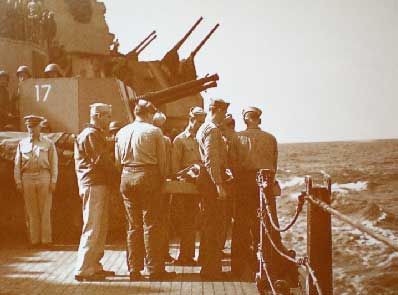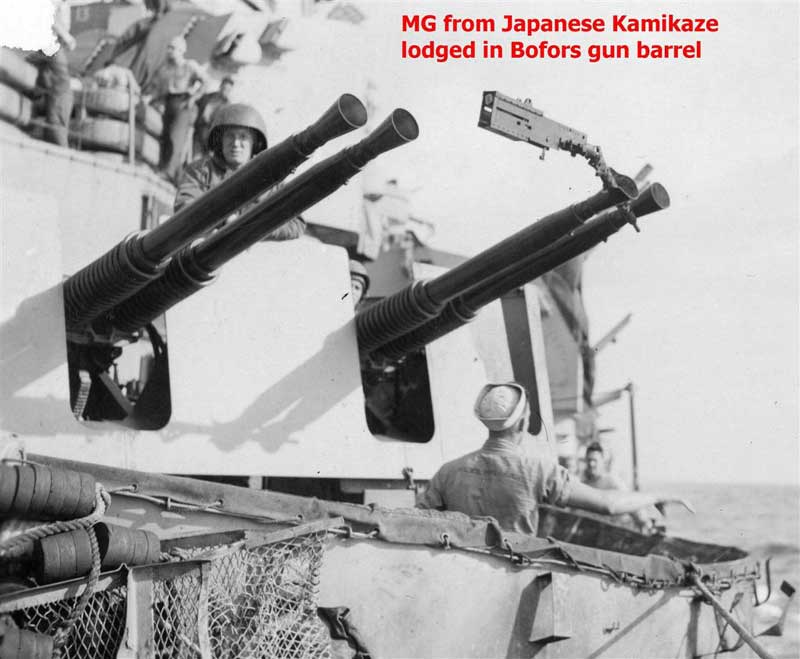I read a story somewhere that the body of the kamakaze pilot was given a military funeral with full honors on the deck where his body was recovered. Can you tell me the Japanese pilots name? The skipper of the Missouri I think his name was Armstrong or something like that. When Manfred von Richthofen was buried he was also given a military funeral with full military honors. All the pall bearers were Captains in the RAF. Do you suppose there are any photos of the Japanese funeral as there are of the von Richtoven funeral? Where would I find them?
What happened to the remains of the Japanese Kamikaze 19 year old pilot, Setsuo Ishino(石野節雄), who crashed into the Missouri? A ceremony took place with a burial at sea. Captain Callahan ( not Armstrong ) held this service not to honor the achievements or values of the pilot but instead to pay tribute to his sense of honor, his willingness to die in combat and his warrior ethics.
On 11 April 1945 Missouri opened fire on a low-flying kamikaze plane which penetrated the curtain of her shells and crashed on the starboard side just below her main deck level. The starboard wing of the plane was thrown far forward, starting a gasoline fire at 5 inch (127 mm) Gun Mount No. 3; yet the battleship suffered only superficial damage, and the fire was brought
quickly under control. The remains of the pilot's body was recovered on board the ship just aft of one of the 40 mm gun tubs. Captain William M. Callaghan decided that the young Japanese pilot had done his job, to the best of his ability and with honor and that he deserved a military funeral.
Not all of the crew agreed with that decision -the pilot was still their enemy and had tried to kill them -but the Captain's orders were respected and the following day the pilot was buried at sea with military honors.

Japanese kamikaze about to crash onboard USS Missouri.
Rear Admiral William McCombe Callaghan (August 8, 1897–July 8, 1991), born
in Chevy Chase, Maryland, was a U.S. naval officer and the first commander
of the USS Missouri (BB-63).
Callaghan graduated from the United States Naval Academy in 1918. After
commanding the USS Reuben James (DE-153) in 1936, he joined the staff of the
Chief of Naval Operations in 1939.
In 1944, Captain Callaghan was named the first commanding officer of the
Missouri, the Navy's newest battleship.
On April 11, 1945, USS Missouri was struck by a kamikaze off the coast of
Okinawa. The damage was minor, and no one died aboard this battleship except
the Japanese pilot, Setsuo Ishino(石野節雄), whose body was recovered. Captain
Callaghan insisted that the young Japanese airman had done his job to the
best of his ability and with honor and deserved a military funeral. The
following day, April 12, 1945, the pilot was given a military funeral at
sea.

Setsuo Ishino(石野節雄) burial at sea
During the Korean War, Callaghan commanded U.S. naval forces in the Far
East. He retired in 1957.
Admiral Callaghan died July 8, 1991, at Bethesda Naval Hospital after
suffering a stroke.

The Machine gun from the Kamikaze aircraft that crashed aboard the US Battleship Missouri.
It is lodged in one of her Quad 40 mm Bofor barrels.
New exhibit at Battleship Missouri Memorial gives emotional look into life during WWII.
A new exhibit at the Battleship Missouri Memorial recently opened in conjunction with a commemorative ceremony on Sept. 2, 2005,** on the 60th anniversary of the end of World War II. Titled “Our World At War,” the exhibit gives visitors a glimpse into life during the war.
“The purpose of this exhibit is to make sense of the surrender - of that incredible moment when the victorious were conciliatory when they could have been vindictive. In order for visitors to understand why that moment was so significant, they need to glimpse the horror of war,” said Mike Weidenbach, curator of the USS Missouri Memorial Association and the exhibit’s creator.
Other elements on display include pieces of the kamikaze plane that crashed into the Missouri during the Okinawa invasion, and a picture of Ishino Setsuo, believed to be the 19-year-old pilot who was given a formal military burial at sea by his Allied enemies.



